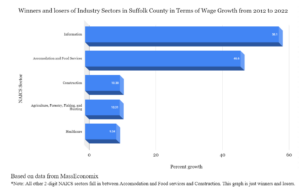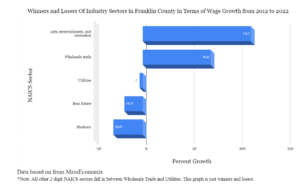Average Weekly Wage Change for two Massachusetts Counties with Differing Densities
In Massachusetts, the success of a given industry can be heavily dependent on which county it is located in. This may be attributed to factors such as geographical differences or population size and density, among many others. Over the 10 years from 2012 to 2022, the average weekly wage (AWW) of various industries have changed at dramatically different rates. When broken down further into counties, the difference is even more stark.
Suffolk County, home to Boston, is naturally the most urban county in Massachusetts. On the opposite end of the spectrum, Franklin County is the most rural of the counties on the mainland, with an average municipal population of roughly 2,660 – Greenfield being the largest municipality (17,656) and Monroe the smallest (115). The industries in these two counties have seen significantly different wage growth and loss, but there are a few similarities.
All statistics in this comparison are based on data retrieved from MassEconomix and use the North American Industry Classification System (NAICS) to categorize industries. Two-digit NAICS codes represent more generalized sectors; however, there can be as many as six digits, each level signaling an increase in specificity. All the wages and percent change are calculated by inflation-adjusted average weekly wages.
Let’s begin by looking at Suffolk County. As the largest county based on population density and home to Massachusetts’ urban core and economic hub, it is no surprise that every two-digit NAICS industry in the county has seen some average weekly wage growth over the decade. The information industry(NAICS code 51) – containing sub sectors such as Publishing Industries (513) and Broadcasting and Content Providers (516) – has seen a 58.1 percent increase in average weekly wages from 2012 to 2022, making it the sector with the largest growth in Suffolk County over this period. Accommodation and Food Service (NAICS Code 72) had the second highest growth with a 46.6 percent increase.
Although no industry in Suffolk County has experienced a loss of AWW, healthcare wages the least – just 9.34 percent during the period. This may be cause for concern, as healthcare faces chronic labor shortages, and by these standards, is not competing effectively against other industries to attract workers. Not far behind healthcare for smallest wage increases, construction and agriculture, and forestry, fishing and hunting both experienced roughly 10.3 percent increases over the decade, relatively insignificant compared to other sectors.

Looking at Franklin, the least densely populated mainland county in Massachusetts, the fluctuations in AWW by industry tend to be far more dramatic than in Suffolk County. The arts, entertainment, and recreation sector (NAICS code 71) saw an astounding 112.7 percent increase in average weekly wage from 2012 to 2022. Wholesale trade (NAICS code 42) saw a 70.81 percent increase. Conversely, three sectors saw decreases in average weekly wages over this period. Utilities (NAICS code 22), real estate (NAICS code 53), and healthcare (NAICS code 62) saw average wages decline by 3 percent, 19.11 percent, and 30.57 percent respectively. Once again, the healthcare industry is the most negatively affected over the period.

In fact, healthcare saw minimal wage growth across all 14 Massachusetts counties. The largest average weekly wage increase was in Nantucket (19.66 percent), and Franklin County had the largest decrease (-30.57 percent). Five counties experienced a decrease in average weekly wages for workers in the healthcare and social assistance sectors. This is a problem that needs to be addressed, and may be partially responsible for the massive shortage of healthcare workers. Without competitive and rising wages, it will be difficult for the healthcare industry to attract the workers it needs.
Dana DiChiro is a Roger Perry Government Transparency Intern at the Pioneer Institute for Summer 2024. She is a rising senior studying Government & Politics and Economics at the University of Maryland, College Park.



